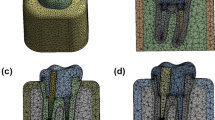Abstract
The periodontal health of abutment teeth and the durability of fixed partial denture depends on the marginal adaptation of the prosthesis. Any discrepancy in the marginal area leads to dissolution of luting agent and plaque accumulation. This study was done with the aim of evaluating the accuracy of marginal fit of four unit crown and bridge made up of Ni–Cr and Cr–Co alloys under induction and centrifugal casting. They were compared to cast fixed partial denture (FPD) and soldered FPD. For the purpose of this study a metal model was fabricated. A total of 40 samples (4-unit crown and bridge) were prepared in which 20 Cr–Co samples and 20 Ni–Cr samples were fabricated. Within these 20 samples of each group 10 samples were prepared by induction casting technique and other 10 samples with centrifugal casting technique. The cast FPD samples obtained were seated on the model and the samples were then measured with travelling microscope having precision of 0.001 cm. Sectioning of samples was done between the two pontics and measurements were made, then the soldering was made with torch soldering unit. The marginal discrepancy of soldered samples was measured and all findings were statistically analysed. The results revealed minimal marginal discrepancy with Cr–Co samples when compared to Ni–Cr samples done under induction casting technique. When compared to cast FPD samples, the soldered group showed reduced marginal discrepancy.








Similar content being viewed by others
References
Rosenstiel SF, Land MF (2006) Contemporary fixed prosthodontics, 4th edn. Mosby-year Book, St Louis
Byrne G (2011) Soldering in prosthodontics—an overview. J Prosthodont 20:233–243
Ziebert GJ et al (1980) Accuracy of one piece castings, preceramic and postceramic soldering. J Prosthet Dent 43:272
Malone WFP, Koth DL (1989) Tylman‘s theory and practice of fixed prosthodontics, 8th edn. Ishiyaku EuroAmerica, Tokyo
Willis LM (1980) Distortion in dental soldering as affected by gap distance. J Prosthet Dent 43:272–278
Huling JS (1977) Compratative distortion in three unit fixed prostheses joined by laser welding, conventional soldering or casting in one-piece. J Dent Res 56:128–134
Sass F, Eames W (1980) Fit of unit-cast fixed partial dentures related to casting ring size and shape. J Prosthet Dent 43:163–164
Hansson O (1985) Casting accuracy of a nickel and beryllium-free cobalt–chromium alloy for crown and bridge prostheses and resin-bonded bridges. Swed Dent J 9:105–115
Hinman R et al (1985) Improving the casting accuracy of fixed partial dentures. J Prosthet Dent 53:466
Holmes JR, Bayne SC (1982) Considerations in measurement of marginal fit. J Prosthet Dent 62:405–408
Cogolludo PG, Suarez MJ, Peláez J, Lozano JF (2010) Influence of melting and casting methods and finish line design on the marginal discrepancy of nickel-chromium-titanium alloy crowns. Int J Prosthodont 23(5):443–445
Kasloff Z (1961) Casting techniques and some variables. J Prosthet Dent 11:533–536
Anusavice KJ (2003) Phillips science of dental materials, 11th edn. Saunders, Philadelphia, pp 295–345
Wu JC, Lai LC, Sheets CG, Earthman J, Newcomb R (2011) A comparison of the marginal adaptation of cathode-arc vapor-deposited titanium and cast base metal copings. J Prosthet Dent 105(6):403–409
Gegauff AG (1989) The seating of one-piece and soldered fixed partial dentures. J Prosthet Dent 62:292–297
Calesini G (2000) One-piece castings in fixed prosthodontics; a study of marginal adaptation using computerized SEM images. Int J Prosthodont 13:275–281
Milan FM, Consani S, Correr Sobrinho L, Sinhoreti MA, Sousa-Neto MD, Knowles JC (2004) Influence of casting methods on marginal and internal discrepancies of complete cast crowns. Braz Dent J 15:127–132
Bruce R (1967) Clinical applications of multiple unit castings for fixed prostheses. J Prosthet Dent 18:359–364
Bauer JR (2006) Microhardness of Ni–Cr alloys under different casting conditions. Braz Oral Res 20:40–46
Konstantoulakis E (1998) Marginal fit and surface roughness of crowns made with an accelerated casting technique. J Prosthet Dent 80:337–345
Schilling ER (1999) Marginal gap of crowns made with a phosphate-bonded investment and accelerated casting method. J Prosthet Dent 18:129–134
Madan N (1999) An investigation into the accuracy of fit of a cast fixed partial denture compared to a soldered fixed partial denture—an in vitro study. J Indian Prosthodont Soc 10:25–28
Fusayama T et al (1964) Accuracy of F.P.Ds made by various soldering techniques and one piece casting. J Prosthet Dent 14:334
Stackhouse JA (1967) Assembly of dental units by soldering. J Prosthet Dent 18:131–139
Lee SY, Lee JH (2010) Effect of soldering techniques and gap distance on tensile strength of soldered Ni–Cr alloy joint. J Adv Prosthodont 2(4):117–121
Author information
Authors and Affiliations
Corresponding author
Rights and permissions
About this article
Cite this article
Jei, J.B., Mohan, J. Comparative Evaluation of Marginal Accuracy of a Cast Fixed Partial Denture Compared to Soldered Fixed Partial Denture Made of Two Different Base Metal Alloys and Casting Techniques: An In vitro Study. J Indian Prosthodont Soc 14, 104–109 (2014). https://doi.org/10.1007/s13191-013-0286-2
Received:
Accepted:
Published:
Issue Date:
DOI: https://doi.org/10.1007/s13191-013-0286-2




